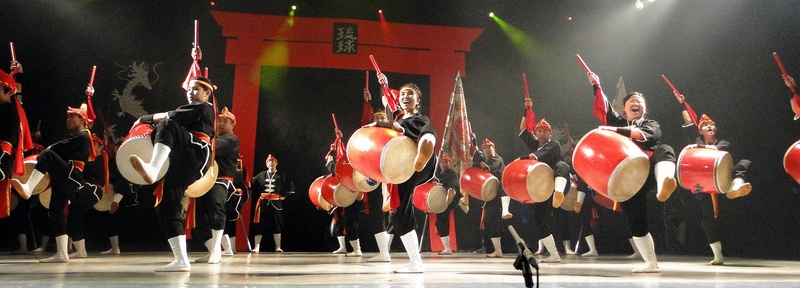In Brazil, there are today approximately 150 taiko groups, according to the Brazilian Taiko Association – ABT. One of the highlights is the Ryukyu Koku Matsuri Daiko Brasil, which preserves Japanese and Okinawan culture, mainly in the country.
About the group
Ryukyu Koku Matsuri Daiko, a name that means “Festive Drums of the Kingdom of Ryukyu”, was founded in Okinawa, a province in the extreme south of Japan, in 1982, by young Okinawans with the ideal of preserving and spreading local culture and traditions through through artistic manifestations using eisā as a reference in their choreography. The work developed by the group mixes traditional music and varied contemporary rhythms.
Currently, the group's headquarters in Okinawa is recognized by the Japanese government due to the social work it develops with young people. Furthermore, such work reveals to new generations the richness and beauty of their own culture, conserving and reinvigorating the “ uchinānchu spirit” (Okinawan spirit).
In addition to Brazil, Matsuri Daiko is present in other countries, such as Argentina, Peru, Bolivia, Mexico and the United States. The Brazilian branch was founded in 1998 by sensei Naohide Urasaki, specialized in Okinawan theater and taiko , and today has around 650 members, at least 90% of whom are Nikkei , distributed across 11 branches (six in Greater São Paulo and the rest in the cities of Campinas/SP, Campo Grande/MS, Brasília/DF, Curitiba/PR and Londrina/PR).
Branches and events
Each branch has its own local projects and activities, each with a specific training day and time. But the branches in Greater São Paulo act differently in relation to presentations, which are carried out with members representing each of the five branches in the region.
There are several presentations that are part of the Ryukyu Koku Matsuri Daiko calendar. In São Paulo, for example, the Okinawa Festival, in Vila Carrão, east of the city, is the most important event of the year, in which the group presents its new songs.
Another major annual event is the Eisa Pageant, a date in which all Matsuri Daiko branches present two songs simultaneously, together with the headquarters, in Okinawa. Therefore, all branches in Brazil and around the world come together to play taiko online in this great celebration.
Matsuri Daiko Brasil has a very close relationship with the headquarters in Okinawa and branches in Argentina, Peru and Bolivia. This is possible due to the exchange of members and participation in major events of each one.
Brazilian members are always well received and participants from branches from other countries are also well received. Thus, several international friendships were made, which are highly valued by the group.
Eisa, the taiko of Okinawa
The Okinawan style of taiko is eisā , an artistic expression typical of All Souls' Day festivals, with choreographed movements that follow the rhythm of the beats. According to a legend, the characteristic beats of eisā are similar to the first sounds we hear in life: the beats of the mother's heart. In tradition, it was men who celebrated festivals and also used taikos to disperse bad energy.
The Ryukyu Koku Matsuri Daiko was the first group to allow women to participate in the Okinawan style of taiko and was also the one that most spread Sosaku Eisa, which would be a modern style, with performances that mix pop music, karate movements and other elements. .
Values: unity and identity
Matsuri Daiko unity comes from the Okinawan proverb, Ichariba Choode , which means “from the moment we meet, we are like brothers”. This spirit crosses borders and makes the group like a big family. Another important value is the recognition of those who have more experience to pass on their knowledge to other generations.
There are also values that are applied in everyday life, such as respect for others and collective conscience. This social responsibility can be seen in the “Amigos do Kokoro” (“Friends of the Heart”) project, created by the Curitiba branch and which is now carried out by all Brazilian branches. The project aims to do good through voluntary activities, such as donating blood, visiting and presenting at NGOs, and collecting supplies and other items that can help these entities.
It is worth highlighting the habit of saying otsukaresama 1 among members to express recognition of everyone's efforts, from going to training, helping, worrying about others to other situations that involve the individual's collaboration with the group. Matsuri Daiko believes that this expression is important to value the participation of members and the feeling of “being part of the group”.
Responsibility to preserve culture
Ryukyu Koku Matsuri Daiko has a very different style of taiko , which attracts many young people to the group. This interest is essential to ensure that Okinawa culture, which is not yet widespread in the country, is passed on to the next generations. The group recognizes that this is a way to gain more space and recognition.
Furthermore, there are few eisā groups in Brazil and, therefore, Matsuri Daiko considers that one of its responsibilities is to preserve this cultural identity. The group not only aims to show a different part of Japanese culture, but also to bring joy to the public and awaken the emotions of spectators.
The group considers it important to preserve the culture of their ancestors out of consideration for the generation that brought it to Brazil, making an effort to consolidate the various Japanese arts within the community and among descendants, and also to disseminate it to non- Nikkei Brazilians.
note:
1. Short form of the expression “ otsukaresama deshita ”, which in Japan is used when a person has finished work and leaves or when they complete something laborious.
© 2016 Tatiana Maebuchi







